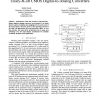Free Online Productivity Tools
i2Speak
i2Symbol
i2OCR
iTex2Img
iWeb2Print
iWeb2Shot
i2Type
iPdf2Split
iPdf2Merge
i2Bopomofo
i2Arabic
i2Style
i2Image
i2PDF
iLatex2Rtf
Sci2ools
ISCAS
2007
IEEE
2007
IEEE
Power/Area Trade-Offs in Low-Power/Low-Area Unary-R-2R CMOS Digital-to-Analog Converters
Abstract— Performance trade offs of unary-R-2R and unarybinary digital-to-analog converters are presented. It is shown that for a given resolution and sampling rate, the active area of the unary-binary converter grows as the operating current of the unit cells approaches the weak inversion region. At very low-currents, the unary-R-2R architecture has a large area advantage over the unary-binary architecture for medium resolution, medium-speed applications.
ISCAS 2007 | Performance Trade Offs | Unarybinary Digital-to-analog Converters | Weak Inversion Region |
| Added | 04 Jun 2010 |
| Updated | 04 Jun 2010 |
| Type | Conference |
| Year | 2007 |
| Where | ISCAS |
| Authors | Babak Nejati, Larry Larson |
Comments (0)

